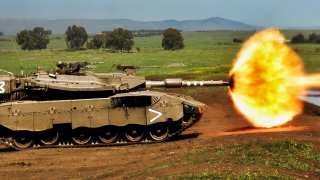Merkava: Israel Just Might Have 1 of the Best Tanks Ever
Hamas’ October 7 attack on Israel highlighted the growing use of drones in modern warfare, particularly against armored vehicles like main battle tanks (MBTs). However, Israel’s Merkava MBTs, equipped with advanced protection systems like the Trophy Active Protection System, proved resilient against these drone assaults.
Summary and What You Need to Know: Hamas’ October 7 attack on Israel highlighted the growing use of drones in modern warfare, particularly against armored vehicles like main battle tanks (MBTs).
-However, Israel’s Merkava MBTs, equipped with advanced protection systems like the Trophy Active Protection System, proved resilient against these drone assaults.
-Designed for survivability with features such as thick armor and a unique front-positioned engine, the Merkava has been a critical asset for the Israel Defense Forces (IDF) for over four decades, helping to protect Israel’s borders even in the face of sophisticated drone threats.
How Israel’s Merkava Tanks Can Survive Hamas’ Deadly Drone Assault
Hamas’ October 7 massacre against Israel showcased the true capacity of the Gaza-based terror group’s drone arsenal. Like other non-state actors, Hamas heavily relies on unmanned aerial vehicles (UAVs) in barrages. Since drones are cheaper to develop and far simpler to produce than other explosive devices, their presence in modern warfare—as seen in the Russian-Ukrainian and Israeli-Hamas Wars—has increased. Drones can carry out a range of functions, including surveillance, reconnaissance, and lethal attacks, which can threaten nearly all military systems and equipment. Tiny, explosive-laden UAVs can be particularly threatening to main battle tanks (MBTs) and other armored vehicles.
As part of Hamas’s offensive strategy this October, the terror group launched lethal drones against Israel’s tanks. However, the Israel Defense Force’s (IDF) fleet of Merkava MBTs is better equipped than most of its counterparts to survive these types of drone barrages.
Introducing the Merkava
The Merkava series of main battle tanks has remained in service with the IDF’s armored corps for more than four decades. Equipped with a range of advanced capabilities, the “Chariot” battle tank is often referred to as one of the best-armored vehicles of its kind across the globe. The Merkava tank can be linked back to the early days of the Israeli state. During the 1967 Six-Day War, Israel’s armored corps attained victory by deploying its fleet of American-made M48 Patton and British-made Centurion tanks across the Sinai Peninsula and into the Golan Heights. Israel’s pre-emptive attack was not well received by some of the new country’s European allies.
In fact, the United Kingdom decided to reverse the joint-tank initiative it was developing with the Jewish state that would have provided Israel with its Chieftain tanks. At the same time, France further embargoed deliveries of its Mirage fighter jets and missile boats to Israel. At this point, Israeli officials understood that it could not rely on foreign allies for security.
To rectify this situation, the then-commander of the IDF armored corps, Maj. Gen. Israel Tal, spearheaded the Jewish state’s MBT domestic production capability. The primary function of Israel’s new tank would be survivability. In order to keep personnel losses down in combat, the new tank was designed with thick-spaced armor and unique engine/transmission positioning to provide extra protection for crews.
By installing the engine and transmission in the front of the tank, more space was created in the MBT’s rear, increasing storage capacity and access to enemy fire for the crew. Other tanks being developed around this time sported a rear-positioned engine, emphasizing the Merkava’s unique internal structure.
Operational history
The Merkava first proved to be a critical asset for the IDF during the 1982 Lebanon War. Outperforming Syria’s fleet of Soviet-designed T-62 armored vehicles, the Merkava became the mainstay of the IDF’s armored corps.
Over the years, several new Merkava variants have been introduced, all sporting new enhancements for the platform to retain an edge over competitors. Perhaps the most significant improvement added to the Merkava was the Trophy Active Protection System. This countermeasure, designed by Rafael Advanced Defense Systems, is installed on the newer Merkava 4 and Merkava 5 variants.
The homegrown system protects the Merkava from an array of projectiles, including anti-tank rockets, anti-tank guided missiles, and high-explosive anti-tank rounds. Additionally, the Trophy system improves the tank’s capacity to locate enemy MBTs, therefore increasing the crew’s survivability. With the Trophy system in place, the Merkava can act more offensively on the battlefield.
As explained by the executive office of the IDF’s tank commander school, “The first and foremost difference in the tank commander’s behavior (pre and post Trophy), we used to be a lot more defensive, and we found ourselves sort of hiding on the battlefield and trying to get out of the range of the anti-tank systems. With Trophy, you feel you have the ability to be more offensive and put yourself out there a little more and allow yourself to accept a little more risk than what we did before.”
Israel’s prioritization of survivability when it comes to the Merkava has boded well for the IDF. Since the Merkava tanks are better protected from top-done drone attacks than its counterparts, Hamas terrorists were unable to destroy as many of these MBTs during its October 7 invasion. While the Merkava may not be invulnerable, it is certainly a critical asset that helps protect Israel’s borders.
About the Author: Maya Carlin
Maya Carlin, National Security Writer with The National Interest, is an analyst with the Center for Security Policy and a former Anna Sobol Levy Fellow at IDC Herzliya in Israel. She has by-lines in many publications, including The National Interest, Jerusalem Post, and Times of Israel. You can follow her on Twitter: @MayaCarlin. Email the author: [email protected].


